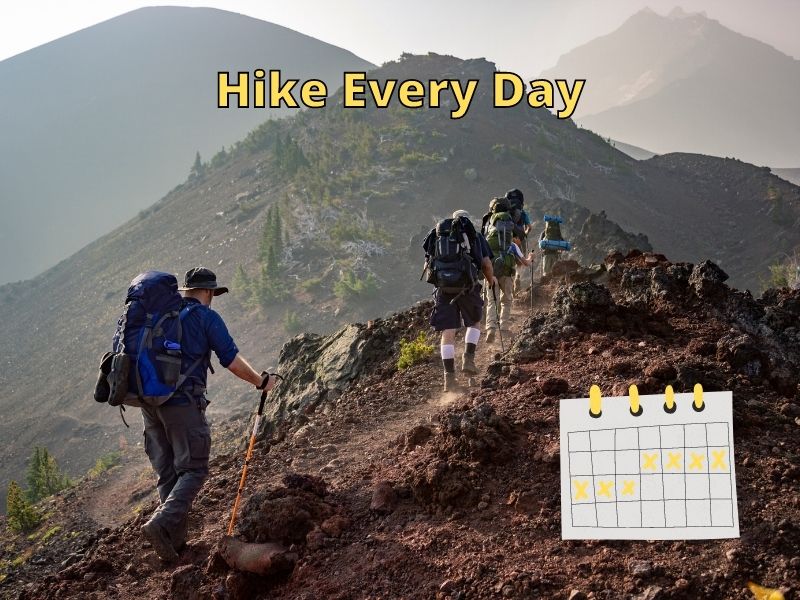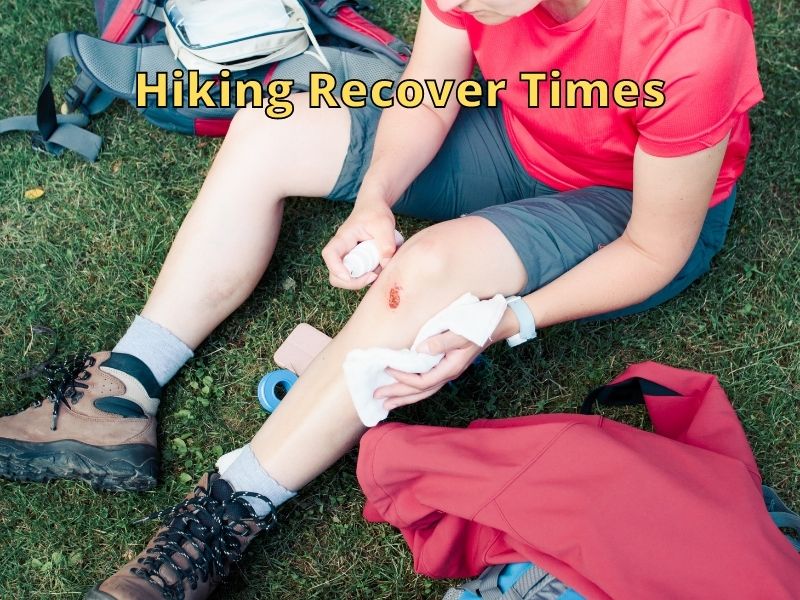I have been on camping trips where I have hiked every day for short periods, such as 2-5 days. Yet, some hikers can spend weeks and months at a time hiking. Does this cause problems, and if so, what are they?
You can hike every day if recovery is a part of your hiking routine. However, hikers need time to heal and recover. Beginning hikers should limit their daily miles, while experienced hikers may hike longer but likely need at least 1 day each week to recover when hiking a lot.
How long one can hike each day depends on many factors, but at some point, hikers need to recover from the stress, strain, and damage caused by hiking. They can limit their time hiking each day, their weight, their path, their gear, or rest for a period in order to hike every day.
How Can I Hike Every Day? [10 Smart Ideas]

Many hikers hike for weeks and months at a time. However, they all usually take weekly breaks or other types of breaks to give their bodies time to recover because hiking a lot is comparable to running in a marathon.
Yet, hikers can take several steps to ensure they can hike every day without stopping. The key is not to go beyond what their body is capable of and avoid injury.
1. Limiting Pack Weight To Hike Longer
For many hikers, their ultimate goal is to reduce pack weight. Hikers want to be able to travel light to travel further without the impact on their joints that comes from a heavy pack.
They try to make all of their items just a little bit lighter, including the clothing they wear. This allows hikers to travel for many days without taking a recovery day. But, of course, how many days depends on each person.
2. Limit Time On The Hikng Trail To Rest Your Body
Those who are hiking all day every day will need to take a day or more break because most people are not built to sustain that kind of punishment without recovery time.
Alternatively, if you only hiked 4 hours a day, you might be able to sustain that for a month if you are a strong hiker who is taking care of yourself.
How far you hike depends on many factors, so monitoring yourself will be key to maintaining a healthy multiday hike.
3. Choose An Easy Hiking Trail Reduces Body Stress
The ascending and particularly the descending on a trail can put lots of stress on your joints. If you can choose a relatively easy path, then you will experience less joint impact.
This should allow you to need less recovery time and possibly hike for more days in a row.
4. Caching Your Food Often When Hiking

You can pick up your food from a cache box along the trail, from a store, or a restaurant on some trails. This impacts how much food and water you need to carry with you each day.
Less food and water packed means you travel lighter. Less weight means less stress on the body and the opportunity to hike longer days and or more days in succession without stopping.
5. Hiking Poles Help Lower Joint and Muscle Stress
Some hikers maintain the idea that using hiking poles reduces joint stress, and the science seems to agree that it can be reduced by as much as 25%. (outdoorgearlab.com)
The stronger your leg, the type of shoes you wear and pack weight all impact joint stress. Having hiking poles can make a difference in how long you hike by reducing impacts and limiting the time needed to recover.
6. Wear The Shoe Best For Your Hiking Adventure
Which shoe to wear is an important question. In general, it seems to me that from everything I know, thick-soled trail runners are best for someone with a light pack if they are hiking every day for weeks or months.
On the other hand, someone with a heavy pack would likely benefit more if they had more rigid hiking boots that fit well. These types of shoes can support the foot better under heavy strain if you get boots that fit well.
7. Increase Water Consumption To Hike Longer
From fewer cramps to more energy, water is essential to maintaining healthy cell function. For example, if you plan to hike every day, you will likely be pushing your body hard, and water will help everything function better.
The muscles will be producing plenty of toxins that water can flush out, and water can help them perform at maximum performance.
Before starting a hiking trip, using a water calculator can be helpful. Start to get your body used to the total amount it should have each day under normal conditions. It will take a couple of weeks for the body to be fully used to new levels, so expect to use the restroom often until then.
Having a fully hydrated body means the cells can communicate better and get things done more efficiently, making your ability to stay on the trail much more likely. As a result, your daily energy and recovery will be better.
8. When Hiking Long Distance Have A Well Thought Out Plan
Planning for the struggles you will likely encounter can help you stay on the trail longer. Building up to a long hike is an excellent way to prepare for the situations that you might encounter when you are far from civilization.
Doing day hikes during the week will help you recognize how prepared you are physically and how well your gear is working for you. In addition, you will likely see what your needs are the more hikes you take.
Plan several overnight trips for a day or two while hiking. You’ll see how well your tent, pack, clothing, and other clothing and equipment are holding up and meeting your needs.
After watching some videos on Youtube and camping/hiking on several outings, you can figure out what will work best for you.
9. Eight Ways To Keep Motivated During Long Dintance Hikes
Monotony can start to set in for hikers for various reasons after hiking for long periods of time. A goal that once sounded exciting and fun may have turned into a choir. So how do hikers keep motivated during long hikes?
Some ways hikers keep hiking day after day are:
- Hike with friends and meeting others often can help motivate us and help us stay positive. While period alone can be healthy, human contact is essential for most people to maintain momentum.
- Set goals often. Setting daily distance and other personal goals on the trail can help hikers maintain a sense of purpose.
- Music, stories, and podcasts. Breaking the silence with music can be fun and entertaining. While the wilderness can be beautiful, your spirits may be down at times and music helps.
- Take pictures and video. Keeping a visual journal to share with others can be very motivating. You can share your ups and downs with others and this can give you a sense of purpose.
- Reward yourself. You’ve been hiking a lot and it’s been tough. Taking some time for personal care or a treat can help you destress, relax, and feel better. This can be done by renting a hotel for a night, eating some good food at a resturant, or other rewards you enjoy while hiking.
- Buy good gear. There’s nothing worse than feeling cold, sore, and unsafe for long periods. You just can’t go on for too long that way. One way to avoid these issues is buying the right hiking gear that is know for its quality.
- Be prepared. Getting lost or hurt and not having any way to deal with these issues can leave you feeling like you don’t want continue after a harrowing experience. Make sure you know the area well and what you need for those conditions.
- Take it slow and steady. Learning to enjoy the journey and worry less about distance traveled each day can help you enjoy your experience more and can lessen stress on the body. Over time, this may help you stay healthy and motivated.
10. Five Ways To Avoid Injury During Extending Hiking Periods
No one can avoid all possible injuries, but being careful can help. Hikers can get injuries because of bad choices, so being aware of situations that may cause injury is key.
- Do shoes prevent injuries? Possibly. Getting used to your hiking shoes and having foot/ankle strength can help, but which shoe should you get?
- Boots that reach over the ankles don’t necessarily make your feet more stable. They may brace your ankle better than a trail runner but the soles are rigid and may make make your feet wobble over rocky ground.
- Trail runners don’t brace your ankle but tend to have much more flexible soles that can help you have “lower center of gravity” and “better tactile feedback” over terrain (sectionhiker.com). You may feel less wobble over rocky ground.
- Do I need hiking poles? Yes. “Studies have shown that trekking poles reduce joint forces and loading of the ankle, knee, and hip joints.” (cooperinstitute.org – Update: page not available) It’s probably a good idea to use hiking poles to prevent injuries over time. ‘
- Should I stay on the trail? Possibly. New hikers are always advised to hike with a partner and always stay on the trail. Getting lost is easier than one might think. Once off the trail the likelihood of injury can increase as well as the likeliness that help will be reduced.
- Do I need a hat? Likely. Besides protection from the sunburns, a hat can help regulate body temperature. The same goes for long sleeve shirts. Clothing can help prevent heat and cold related problems, as well as some bug bites.
- Are the socks I wear important? Yes. From blisters to peeling skin, wearing the right socks can prevent a lot of foot pain and help your shoes feel more snug so they don’t wobble. Getting the right hiking socks will greatly improve foot health.
Recover Times Needed For Hiking Every Day?

For each person, recovery time will be different. Some people can hike seven days a week and still be OK as they start hiking into the next week. Nothing is sustainable forever, though. Yet, some hikers find a good hike/recovery cycle where they don’t need to stop too much.
They can hike each day because they tend to carry a light pack, use poles, have good shoes, and follow health routines for maintaining their body.
Once the body starts showing signs that things are getting stressed, hikers must address these issues or risk getting hurt. Other times you get injuries and have to decide to keep going or recover at home.
In general, all-day hikers need 1-2 days each week to rest from hiking.
5 Common Hiking Injuries/Symptoms
We’ll review some of the most common problems that hikers have when hiking. I’ll include how much recovery time each problem is likely to take.
- Muscles knots – A massage can take 10-15 minutes to relieve a knot. Some knots may be more stubborn and persist for several days. Try other methods to relieve them.
- Heat can loosen muslce or use cold for a swollen muscle.
- Exercise can help release the knot, just be careful because pushing hard could cause a muscle strain and tearing.
- Press down on the knot for 10 seconds and release. Then repeat until it begins to release.
- Hydrate well with water to help muscles function properly and release.
- Roll a tennis ball over the knot. Like a massage, this can help loosen the knot.
- Swelling – This usually requires a cold compress to help reduce the swelling. During hiking, swollen feet can be caused by standing to long (especially if not used to it – a heavy pack or ill fitted shoes), injury, infection, or possibly insect bit.
- For injuries, swelling can be reduced quit a bit when you are off your feet but will return when hiking. Then more time you can spend off your feet the more likely the injury will heal. Time can range from a few days to a few months.
- Changing shoes or reducing pack weight could help reduce swollen feet.
- Infections and insect bits should be looked at by a doctor to rule out anything serious. A doctor may subcribe antibiotics and the swelling should go away in 1-3 days. (uptodate.com)
- Blisters – A blister can be simple or difficult to deal with depending on how big it is, where it’s located, and if it has opened up.
- A blister can be treated quickly and heal within a few days depending on conditions.
- The right shoes and socks can help prevent blisters. Addition aids such as anti-chaffing balms and mole skin can also make a big difference in reducing the occurance and length of blisters.
- If infection occurs it’s important to see a doctor.
- JointPain – Your joints can start to hurt for various reasons. When hiking the excessive use and high pressure on your joints can cause pain and swelling. Different parts of the joint can get irritated or injured.
- If your knee just hurts but isn’t injured, you can start feeling better the next day if your pack weight is reduced. It depends on levels of irritation and if your walking down hill.
- If you are going up and down hills each day, the pain may last longer depending on leg strength, use of poles, type of shoes, weight of pack, etc. Reducing pack weight to lower levels could prevent joint pain.
- If you have type of small or large joint injury, expect pain to come and go depending on the severity of the injury and the stress the joint is under. Expect to have relief ” in 1 to 2 weeks, but it can take 3 months” for some injuries. (myhealth.alberta.ca)
- Muscle pain – Muscles can hurt for several reasons. When you are walking all day your muscles start to hurt because they aren’t used to being worked so much. Yet, other times you actually damage your muscles.
- Sometimes this pain can go away after a day or so, and as you continue to hike you will likely feel less and less pain over time as your muscle adjust to the daily routine.
- Sometimes you strain a muscle and “Grade I strains heal within a few weeks. Grade II tears can take up to 3 months or longer.” (medicinenet.com)
Conclusion
For each person and circumstance, the number of days they can hike in a row will be different. For example, beginners will need to hike fewer miles to endure hiking for long periods, while experienced hikers will need to watch for over-stressing their bodies.
With good equipment, physical preparation, emotional support, and having a good plan, you can go many days and hike without stopping.
Whether you plan to hike the Pacific Coast Trail, the Appalachian Trail, or something else, you can hike more days in a row by carefully managing your trip before and during your multiday treks into the wild.
Thanks for visiting Helpshoe.com
References

